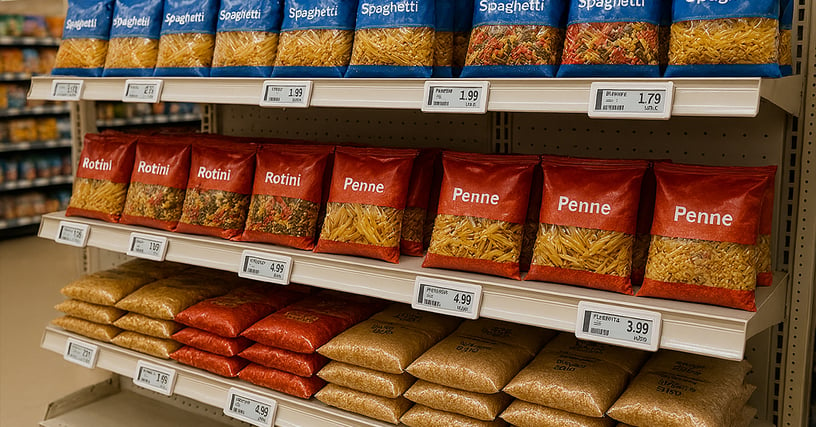Retailers are rethinking electronic shelf labels as critical enablers of unified commerce, powering sustainable, omnichannel-ready, and analytics-rich retail.

The digital shelf is an overlooked catalyst for store transformation
Picture this: A customer walks into your store after checking product availability online. The item shows in stock, but the shelf is empty. The price displayed doesn't match your mobile app. An associate spends fifteen minutes manually checking systems while the customer grows frustrated.
This scenario costs retailers millions in lost sales daily, and it's completely preventable. As retailers advance toward unified commerce, the most overlooked asset in their transformation strategy is the shelf itself: the electronic shelf label (ESL).
ESLs no longer serve as digital replacements for paper price tags. They now sit at the intersection of pricing integrity, real-time inventory management, associate productivity, and sustainability. These wireless, battery-powered displays use e-ink technology for clear visibility and long battery life, while built-in LED indicators guide associates to specific products for fulfillment tasks. Advanced ESL systems integrate seamlessly with existing retail infrastructure through APIs, enabling automated price updates, inventory alerts, and customer engagement features that transform the traditional shelf into an intelligent retail touchpoint. Most importantly, they close the operational gap between physical and digital retail.
Yet many retail leaders continue seeing ESLs as a functional upgrade, not a strategic one. That's a costly oversight preventing them from unlocking unified commerce's true potential.
Enabling real-time responsiveness in unified commerce
Today's consumers operate in a fluid, multi-channel environment where context and timing drive purchasing decisions. This behavior demands infrastructure that responds instantly to changing conditions, inventory levels, and customer preferences.
Digital shelves enable what paper labels never could: real-time orchestration of the entire store ecosystem. When inventory runs low, ESL systems redirect customers to alternative products, suggest online ordering for home delivery, or highlight complementary items in stock.
According to Incisiv's 2025 Unified Commerce Benchmark, 64% of unified commerce leaders maintain real-time inventory visibility across channels, compared to just 22% of others. This capability gap reveals why digital shelf infrastructure has become a strategic differentiator.
Walmart's deployment validates this transformation: Expanding digital shelf labels to 2,300 stores by 2026, managing over 120,000 products with thousands of weekly pricing updates. Price changes that previously took two days now complete in minutes, freeing associates to focus on customer service rather than manual tasks.
Value left on the shelf reflects a deeper operational inefficiency
The most significant hidden ROI lies in ESL systems' data generation capabilities. Every price change, promotion display, and customer interaction creates data points revealing behavioral patterns and optimization opportunities. This granular information enables personalization at scale, which is impossible with static labeling systems.
Retailers can test pricing elasticity in real-time across locations, adjust promotional messaging based on demographics, and optimize product placement based on interaction patterns. The ability to execute A/B tests across thousands of locations simultaneously provides competitive intelligence driving immediate revenue and long-term positioning.
This intelligence extends to inventory optimization. ESL systems enable dynamic markdown strategies, maximizing revenue from aging inventory, automatically trigger replenishment alerts, and coordinate pricing across channels to prevent margin erosion.
The competitive advantage is clear: retailers with advanced ESL analytics make data-driven decisions in real-time while competitors rely on outdated manual processes and delayed insights that miss critical optimization opportunities.
ESL drives sustainability impact while many brands still miss out
The environmental case for ESL adoption is gaining traction as retailers face growing pressure from regulators, investors, and consumers to reduce waste and carbon emissions. Traditional shelf operations create substantial waste through constant printing, re-labeling, and overstock management.
Digital shelf systems eliminate paper and ink usage from pricing workflows, reduce markdown-related shrink through improved price agility, and avoid unnecessary replenishment through shelf-level inventory visibility. This operational shift supports sustainability goals while improving efficiency.
For retailers pursuing ESG targets, digital shelf technologies offer a direct, quantifiable path to measurable impact, particularly in high-SKU environments like grocery, electronics, and DIY, where label turnover is highest.
Smart retailers discover that ESL sustainability benefits often justify the investment independently, with operational and strategic benefits representing additional upside rather than the primary business case.
From display to decision engine
Today's ESL systems integrate with broader digital shelf infrastructure, including IoT-enabled sensors, edge computing for real-time alerts, AI-powered shelf cameras for compliance monitoring, and dynamic displays showing personalized pricing and promotions.
In this configuration, ESLs become intelligent nodes rather than just display devices. They enable proactive replenishment, accurate forecasting, and task automation for associates while generating shelf-level analytics previously unavailable or too costly to capture.
This integrated approach transforms retail merchandising from static displays to dynamic, responsive customer engagement platforms. The shelf becomes a data collection point informing broader business strategy and operational optimization.
Intelligence gathered extends beyond individual product performance to reveal customer journey patterns, seasonal trends, and cross-category behaviors that drive sophisticated merchandising and marketing strategies.
ESL becomes a foundational enabler of unified commerce integration
The most transformative ROI comes from ESL integration with broader retail technology ecosystems. When connected to POS systems, inventory management platforms, CRM tools, and e-commerce platforms, digital shelves become the physical manifestation of unified commerce strategy.
This integration enables capabilities redefining customer experience: personalized pricing based on loyalty status, real-time inventory visibility across channels, automated promotional campaigns responding to inventory levels, and seamless transitions between digital and physical shopping.
Consider the competitive implications: while competitors struggle with channel conflicts and operational inefficiencies, retailers with integrated ESL systems offer consistent, real-time experiences, building customer loyalty and driving repeat business.
Incisiv's research shows multi-channel customers spend up to 3x more annually than single-channel shoppers, which is direct validation of the unified commerce infrastructure that ESL systems enable. This advantage compounds as customer acquisition costs continue rising.
Strategic execution: Why shelf digitization can’t be deferred
The question facing retail leaders isn't whether to invest in ESL systems, but how quickly they can implement them strategically. Retailers gaining a competitive advantage today treat digital shelves as infrastructure investments, enabling broader business transformation, not just operational improvements.
Success requires thinking beyond traditional ROI metrics to consider strategic capabilities, competitive positioning, and long-term value creation. When implemented with unified commerce objectives, ESL systems deliver returns extending far beyond labor savings into customer experience differentiation.
The hidden ROI of electronic shelf labels lies not in what they replace, but in what they enable. Smart retailers recognize this distinction and build competitive advantages through integrated digital shelf strategies, defining industry leadership.
The shelf edge has become strategic, and the window for competitive advantage is closing rapidly. Retailers acting decisively on ESL implementation today establish operational advantages that become increasingly difficult for competitors to match over time.





